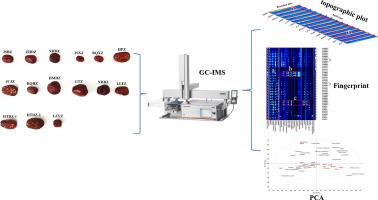Assessment of the aroma profiles of 15 commercial Chinese jujubes using gas chromatography-ion mobility spectrometry
IF 7.2
Q1 FOOD SCIENCE & TECHNOLOGY
引用次数: 0
Abstract
Jujube is the homology of medicine and food, which popular for its characteristic flavor. Aroma is one of the most key factors that determining the quality of commercial Chinese jujube. In this study, gas chromatography-ion mobility spectrometry (GC-IMS) was applied for aroma characterization of 15 varieties of commercial Chinese jujubes. Results showed a total of 29 aroma compositions were identified, and aldehydes (10.42%−22.87%), ketones (26.45%−42.06%), alcohols (2.42%−7.30%), and esters (16.41%−26.86%) were common in 15 varieties of commercial Chinese jujubes. 3-Hydroxy-2-butanone, methyl acetate, benzaldehyde, 2,3-butanedione and 2-methylbutyric acid contributed great to the aroma profiles of different commercial Chinese jujubes. Moreover, significant (P<0.05) differences of aroma profiles were found among 15 varieties of commercial Chinese jujubes, and it can be well distinguished by 3D-topographic, characteristic fingerprint and principal component analysis (PCA) results. In conclusion, JSBZ (Ji Shan Ban Zao), HMDZ (Ha Mi Da Zao) and HPZ (Hu Ping Zao) respectively presented significantly different aroma profile characteristics. GC-IMS instrument and PCA statistical method were superior and effective in assessing the differences of aroma profiles of different commercial Chinese jujubes.

气相色谱离子迁移谱法评价15种商品枣的香气特征
枣是药食同源物,因其独特的风味而广受欢迎。香气是决定商品红枣品质的关键因素之一。本研究采用气相色谱-离子迁移谱法(GC-IMS)对15个商品枣品种的香气进行了表征。结果表明,15个商品枣品种共鉴定出29种香气成分,其中醛类(10.42% ~ 22.87%)、酮类(26.45% ~ 42.06%)、醇类(2.42% ~ 7.30%)和酯类(16.41% ~ 26.86%)较为常见。3-羟基-2-丁酮、乙酸甲酯、苯甲醛、2,3-丁二酮和2-甲基丁酸对不同商品枣的香气特征影响较大。此外,15个商品枣品种香气谱差异显著(P<0.05),并可通过三维形貌、特征指纹图谱和主成分分析(PCA)进行区分。综上所述,JSBZ(鸡山斑藻)、HMDZ(哈米大藻)和HPZ(胡平藻)分别具有显著不同的香气特征。GC-IMS法和PCA统计方法在评价不同商品枣香气谱差异方面具有优越性和有效性。
本文章由计算机程序翻译,如有差异,请以英文原文为准。
求助全文
约1分钟内获得全文
求助全文

 求助内容:
求助内容: 应助结果提醒方式:
应助结果提醒方式:


